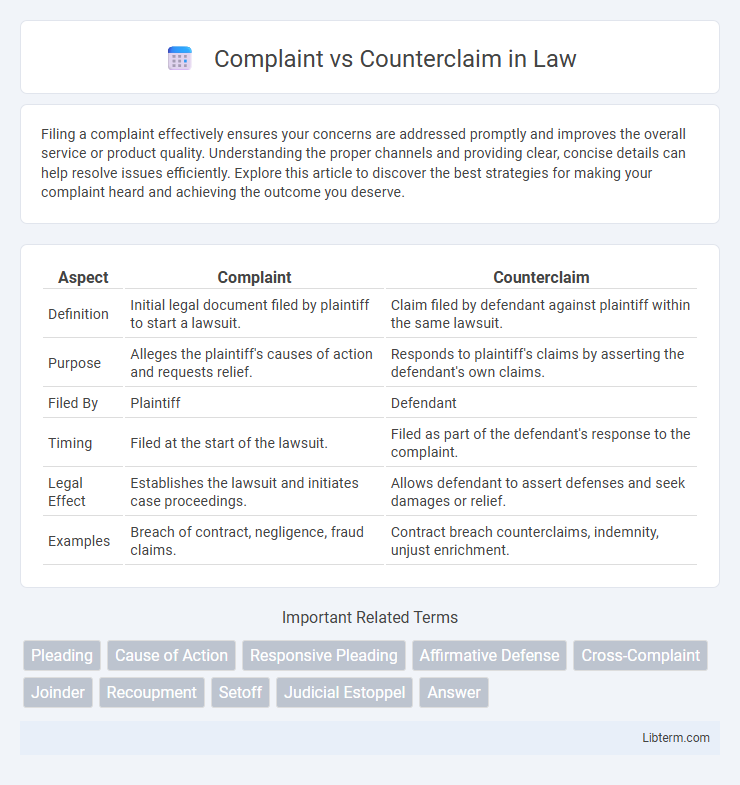Filing a complaint effectively ensures your concerns are addressed promptly and improves the overall service or product quality. Understanding the proper channels and providing clear, concise details can help resolve issues efficiently. Explore this article to discover the best strategies for making your complaint heard and achieving the outcome you deserve.
Table of Comparison
| Aspect | Complaint | Counterclaim |
|---|---|---|
| Definition | Initial legal document filed by plaintiff to start a lawsuit. | Claim filed by defendant against plaintiff within the same lawsuit. |
| Purpose | Alleges the plaintiff's causes of action and requests relief. | Responds to plaintiff's claims by asserting the defendant's own claims. |
| Filed By | Plaintiff | Defendant |
| Timing | Filed at the start of the lawsuit. | Filed as part of the defendant's response to the complaint. |
| Legal Effect | Establishes the lawsuit and initiates case proceedings. | Allows defendant to assert defenses and seek damages or relief. |
| Examples | Breach of contract, negligence, fraud claims. | Contract breach counterclaims, indemnity, unjust enrichment. |
Understanding Complaints: Definition and Purpose
A complaint is a formal legal document filed by the plaintiff initiating a lawsuit by outlining the facts and legal reasons for the claim against the defendant, seeking judicial relief. It serves to inform the court and the defendant of the basis of the lawsuit, specifying the allegations and the damages or remedies requested. Understanding the complaint is essential as it frames the scope of the dispute and triggers the defendant's obligation to respond, setting the stage for the litigation process.
What is a Counterclaim? Key Concepts Explained
A counterclaim is a defendant's claim filed against the plaintiff in response to the original complaint, seeking damages or relief. It must arise from the same transaction or occurrence as the plaintiff's complaint and is included in the defendant's answer. Courts use counterclaims to efficiently resolve related disputes within a single lawsuit, preventing multiple legal actions over the same issue.
Legal Grounds for Filing a Complaint
A complaint is the initial pleading filed by the plaintiff outlining the legal grounds for the lawsuit, such as breach of contract, negligence, or violation of statutory rights. It must state specific facts supporting each cause of action, establishing a prima facie case to proceed in court. Legal grounds for filing a complaint are based on demonstrating the defendant's liability under applicable laws and the harm suffered by the plaintiff.
Elements Required in a Counterclaim
A counterclaim must contain specific elements including a clear statement of jurisdiction, identification of parties involved, and a concise explanation of the facts supporting the claim. It requires a demand for relief, mirroring the plaintiff's request, and must relate directly to the subject matter of the original complaint or arise from the same transaction or occurrence. Properly formatted and timely filing are crucial to assert a valid counterclaim within the procedural rules.
Differences Between Complaints and Counterclaims
A complaint initiates a lawsuit by outlining the plaintiff's allegations and legal claims against the defendant, while a counterclaim is the defendant's response asserting their own claims against the plaintiff within the same case. Complaints establish the original cause of action, and counterclaims can either be related to the original claim (compulsory) or separate issues (permissive). The primary difference lies in their roles: a complaint sets the lawsuit in motion, whereas a counterclaim serves as a defensive and offensive tool within the ongoing litigation.
Procedural Steps: Complaint vs. Counterclaim
The procedural steps for a complaint typically begin with drafting the initial complaint document, filing it with the court, and serving it to the defendant, who must then respond within a specified timeframe. A counterclaim arises during the defendant's response phase, where the defendant asserts their own claim against the plaintiff within the answer or a separate pleading, subject to specific court rules. Both complaint and counterclaim processes require compliance with jurisdictional requirements, proper service, and adherence to deadlines to ensure valid procedural progression.
Strategic Considerations in Filing a Counterclaim
Filing a counterclaim strategically can enhance a defendant's position by potentially offsetting liability or creating leverage in settlement negotiations. Evaluating the strength and relevance of a counterclaim relative to the original complaint is essential to avoid unnecessary complications and legal costs. Timing and jurisdictional factors also impact the effectiveness of a counterclaim in achieving favorable outcomes.
Common Examples: Complaint and Counterclaim Scenarios
In a personal injury case, a plaintiff's complaint alleges negligence causing harm, while the defendant's counterclaim might assert that the plaintiff was partially responsible for the accident. In a breach of contract dispute, the complaint typically claims nonpayment or failure to perform, whereas the counterclaim may argue the original contract was modified or the plaintiff breached first. Employment litigation often involves complaints about wrongful termination, with counterclaims challenging the plaintiff's adherence to company policies or alleging defamation.
Legal Consequences of Complaints and Counterclaims
Filing a complaint initiates a lawsuit and establishes the plaintiff's claims against the defendant, potentially leading to remedies such as damages or injunctions if proven. A counterclaim, asserted by the defendant in response, introduces separate claims against the plaintiff, which can alter the litigation's dynamics and may result in mutual liability or offsets. Both complaints and counterclaims affect legal strategies, court jurisdiction, and potential outcomes, including settlement negotiations and court rulings.
Tips for Responding to Complaints and Counterclaims
When responding to complaints and counterclaims, it is crucial to adhere to the specified deadlines and carefully review the factual allegations and legal claims presented. Draft a clear and concise answer that directly addresses each point, either admitting, denying, or stating insufficient knowledge to respond. Consulting with a qualified attorney can ensure that procedural rules are followed and that any affirmative defenses or counterclaims are properly asserted to protect your legal interests.
Complaint Infographic

 libterm.com
libterm.com